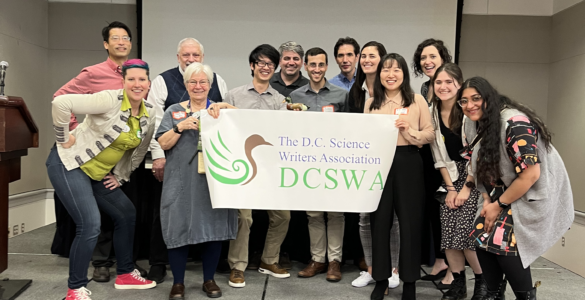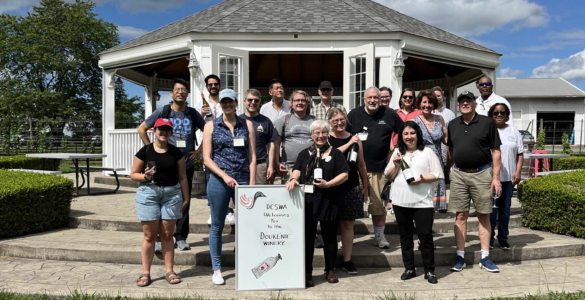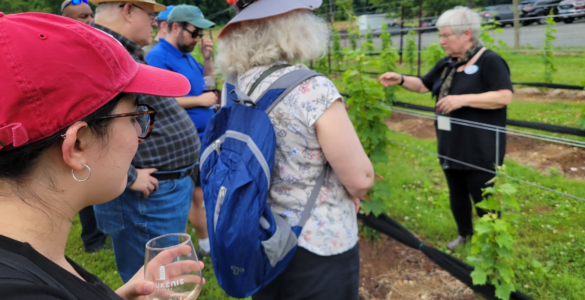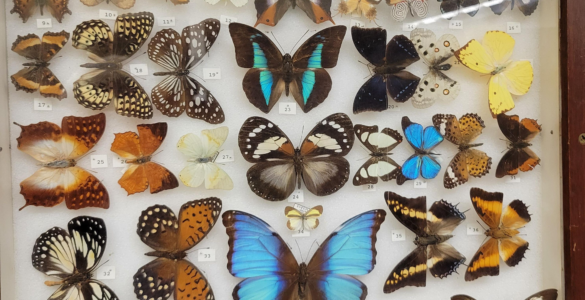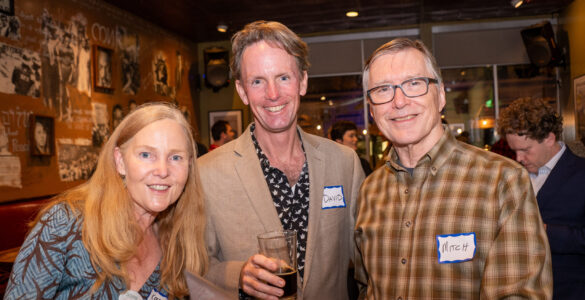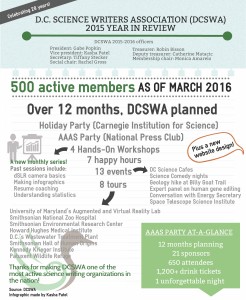Author Archives: President
From Ideas to Books
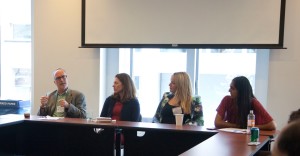
You don’t have to make the journey from idea to book alone
By Abree Murch
As writers and communicators, we know that feeling when a story grabs us – that nagging thought that sinks its teeth in and keeps us up at night thinking, “Someone needs to write this.” This “crush” on an idea, according to Ross Yoon literary agent Anna Sproul-Latimer, is a great sign that it has commercial book potential and that you should be the one to write it.
Sproul-Latimer was a panelist in the “From Ideas to Books” breakout session at DCSWA’s 2016 Professional Development Day. She joined two published authors to speak on the mechanics and hard work of turning a great idea into something publishable and sellable.
Sproul-Latimer cited her experience selling New York Times-bestselling nonfiction to encourage the aspiring authors in the room to make sure they use a good agent who knows how to sharpen an idea into commercial book material. Quoting her colleague Gail Ross, Sproul-Latimer defined a successful book as “a table resting on four legs: a good idea, a good author platform, a good agent and a good book proposal”—the idea being the most important leg. It has to be similar enough to stories that are already written that publishers and readers will recognize it, but different enough that it hasn’t been told and there is a clear place for it in the market.
Panelist Kim Stephens related her experience as a first-time author working through the process. “For anyone who’s in the Word document stage, it can happen,” she said, holding up a copy of her new book, The Prodigy’s Cousin: The Family Link Between Autism and Extraordinary Talent. Stephens, a “recovering lawyer,” co-authored the book with her mother, and the pair worked with an agent. But she also cited the importance of finding a supportive writing community that has the technical knowledge to advise you. Stephens also cautioned against talking to too many experts during the research phase: “You don’t want to lose your own eye, your own voice or your own perspective on a topic.”
Unlike Stephens, author and panelist Ivan Amato didn’t use an agent, a fact he readily acknowledged may have been a financial mistake. He did, however, leverage his contacts and ideas from his work as a reporter on materials science, which led him to write Stuff: The Things The World Is Made Of and Supervision: A New View of Nature, among others. He has also written organizational histories, and encouraged the audience to explore the places they work as sources of inspiration.
It was apparent from the panelists’ collective experience that, while bringing an idea to life is hard work, aspiring authors need not feel as though they have to take on the daunting task alone. The important part, as Stephens put it, is believing in your book. “There are no guarantees. Publishing is a hugely up-and-down industry, and I think knowing what it is you want to accomplish with your book will get you through the process in a healthier way.”
See all Professional Development Day 2016 session highlights
Freelance writing: Exploring the alternatives
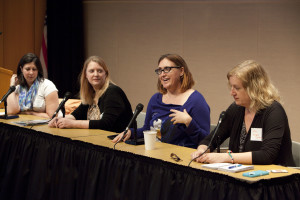
By Mikel Shybut
Newspapers and big-name magazines are notoriously hard to break into. But many smaller or more specialized publications are in constant need of talented science writers, according to panelists at a session during DCSWA’s 2016 Professional Development Day.
Lauren Lipuma, public information specialist and writer for the American Geophysical Union, moderated a panel of writers and editors who discussed alternative opportunities for science writers, the importance of freelancing, and strategies for pitching to editors.
Endless opportunities
Sadie Dingfelder, feature writer at the Washington Post Express, encouraged attendees to practice what she calls “stealth science writing” when pitching ideas to big-name non-science magazines.
“Any story can be a science story,” she explained. “Any magazine you pitch to, big national magazines or newspapers, if you can think of a way to work science into your story, that’s going to make your story better.” Dingfelder cited an article she wrote in the travel section of the Washington Post ostensibly about visiting Belize, but actually focused on the invasive species of lionfish plaguing the area.
Alumni magazines
Alumni magazines are another popular market for pitching. “You could pitch the editor about neat research being done at the school, or interesting alumni who are scientists,” Dingfelder advised.
Amy Rogers-Nazarov, a journalist who has written for many trade, consumer and alumni publications, noted that alumni magazines also pay well. “In my experience, most of them are $1.00 per word or better,” an important benchmark for many writers.
Rogers-Nazarov suggested that any time a writer is interviewing a scientist, “find out where they went to college, find out where they got their graduate degree and start pitching.”
Trade publications
Erin Boyle, managing editor and communications manager for the American Society of Radiation Oncology, discussed opportunities in writing for trade publications. These come in two flavors: those associated with professional societies and those that are independent media outlets.
These publications are always on the lookout for freelance science writers, and many are published weekly or monthly, or even daily during their international conferences. The opportunities are plentiful. “If an area of medicine fascinates you, just Google the topic,” Boyle suggested for finding related trade publications.
Freelancing for all
Each panelist highly recommended freelancing, even if writers have a full-time job. “It allows you to form a professional identify outside of whatever your current job is,” Dingfelder said. “When you freelance you make professional connections that are really important; you expand your portfolio, which is very important; and also you pave your way to getting your next job.”
While freelancing, writers should value their time and effort. “Your hourly rate is the only one that matters,” Rogers-Nazarov said, advising writers on how to weigh writing opportunities. “You should definitely never be working for free,” Dingfelder added, suggesting that those with a regular job can shoot for bigger-name publications such as a Washington Post blog, which may or may not pay well, but are great resume builders.
Time to pitch
When it comes to pitching, strategies may differ depending on the publication. As a trade editor, Boyle requires a résumé and a reason why the writer was suitable for that publication; essentially a writer is pitching him- or herself. She noted that professional societies often have specific stories in mind to assign writers.
For most mainstream publications, by contrast, it’s all about pitching the story. Dingfelder advised looking at recent stories and pitching something in the same fashion but that hasn’t been covered for at least five years. “The way to craft a successful pitch, I’ve found, is to practically write the whole story,” she suggested, “to do a ton of research, to actually do some interviews, and to basically write the lead of your amazing story and send it directly to the editor.”
See all Professional Development Day 2016 session highlights
Beyond Blogs: Be a Better PIO

Beyond Blogs: Be a Better PIO
By Monika Joshi
An important but sometimes underappreciated role in the science writing universe is that of the public information officer, or PIO, who acts as an intermediary between scientists and institutions, and the media and the public. The panelists for this session brought to the table experiences from PIOs in a range of positions, including within government agencies, universities, and non-profits.
Rick Borchelt, director of the Office for Communications and Public Affairs at the Department of Energy’s Office of Science, kicked off the session with what he called the number one question PIOs should ask themselves: Who is the audience you are serving?
The panelists stressed that a PIO’s job is to advocate on behalf of the organization and help tell its story as well as possible to all stakeholders. This can mean looking beyond the media relations aspect of writing press releases, and focusing efforts on communicating at other levels, such as with Congress and the research community. “People are paying for [your organization’s] research with tax money,” Borchelt said. “They deserve to see the information they are paying for.”
The panelists shared numerous tips for increasing the chance of getting work from PIOs’ institutions covered, including:
- Find the offbeat stories not already being covered by mainstream media.
- Follow what’s trending on TEDTalks. This is often where reporters and news organizations are tapping in.
- Be immersed in what your colleagues and scientists are doing, even before they are at the point of being published.
- Send targeted pitches to reporters, but only after the official press release has been put out. (There was consensus on the panel that it is unethical to be exclusive about which reporters you inform about a press release.)
- Be cute, photogenic and energetic in how you craft your pitches, stories and social media content.
Jeff Cronin, communications director at the Center for Science in the Public Interest, emphasized how social media could be used to push for change. He gave an example of how his organization advocated to get trans fat out of the food supply by surveying and revealing nutrition information about restaurants around the country. After the organization tweeted that Long John Silver’s had the “worst restaurant meal in America” (33 grams of trans fat per meal!), the chain pledged to eliminate trans fat from their menu.
Mitch Waldrop, features editor at Nature and former PIO, cautioned against giving reporters too much access, citing an example from a personal experience. Once, while working at the National Science Foundation, he allowed a reporter to escort himself out after meeting with him. The reporter decided to snoop around and ended up outside the offices of executive staffers.
On the subject of working with reporters and helping them make stories accurate, Matt Wright, science writer at University of Maryland, College Park, recommended “treat[ing] the interview as less of an interrogation and more of a conversation. Ask up-front if you’ll be able to see the story or quotes before it is published.”
A unifying theme of the session was to “think like a journalist, even as a PIO,” as Wright put it. The speakers agreed that the skills reporters develop—being cautious, being skeptical, trusting but verifying, taking more notes than you need—are just as useful for PIOs.
No matter where in science communications you end up, stay a journalist “under the helmet,” Wright said.
See all Professional Development Day 2016 session highlights
Developing the power of discernment
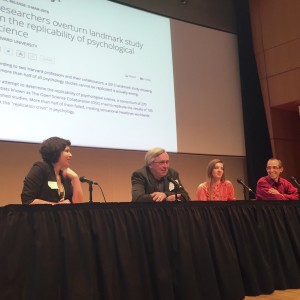
Developing the power of discernment
By Nate Rabner
Science journalists often face a dilemma: Newsworthiness is key to bringing in readers, but the pursuit of newsworthiness above accuracy or context is a recipe for disaster. Minding both elements can be difficult in science journalism, where progress far more often occurs incrementally than through large, headline-grabbing leaps.
In the session “Being a discerning reporter” at DCSWA’s 2016 Professional Development Day, a panel of writers and editors offered tips for navigating this challenge, finding stories that matter and getting them right.
Misinterpreted statistics
Science News managing editor and blogger Tom Siegfried presented a “recipe for wrong science”: a new development in a hot field that claims to overturn previous beliefs – otherwise known as a big scoop for a science journalist.
His first key to avoiding these stories is understanding p-values and confidence intervals. These statistical measures can be unreliable, Siegfried warned: A p-value, which compares observed results to modeled predictions, can be “a substitute for thought where thought is actually very important,” he said, helping poorly constructed studies make their way to journals and from there to your news feed.
Misrepresented findings
Even if a study yields well-supported conclusions, it’s still vulnerable to manipulation by others, panelists warned. Will Saletan, a senior reporter at Slate, spoke about his experience reporting on genetically modified organisms, or GMOs, a field rife with disingenuous critics.
To tell legitimate concerns from unfounded gripes, he said, journalists should “make the merchants of doubt put forward a hypothesis” and take a turn defending a factual assertion for a change. He also recommended using “control groups” to expose double standards, as when he picked apart the criticism that the pesticide Bt in GMO crops is dangerous: “Really?” he asked. “’Cause there’s an organic Bt spray that all your organic farmers use.”
Exaggerated impacts
The final place a story can be distorted is on a reporter’s or editor’s computer. Julie Beck, a senior associate editor at The Atlantic, reminded the journalists in attendance that it’s important not to force a conclusion onto an inconclusive study – even if you’re writing a 5,000-word feature about it. “A lot of times in science journalism, there is a pressure to … say, ‘Science says blah,’” she said. “A lot of times that is not the case – there is no clear answer,” whether because the answer hasn’t been found yet, researchers don’t agree on it, or the answer is ultimately unknowable.
Beck also shared her research process: Comb through Google, abstracts and books to compile a mass of notes, then “gargle on the sea of studies and then spit out something that you hope is helpful.” Learning the history behind a study reduces the risk of ignoring precedent, and comparing methodologies can demystify seemingly surprising findings.
Taking the time you need
All these tactics contribute to averted embarrassment. Moderator Rachel Gross, a Slate editorial assistant, recalled Open Science Collaboration’s recent psychology reproducibility project, which led media to call the field’s credibility into question, only to be criticized by scientific responses that were themselves misrepresented. Getting the story right is worth the time it takes, she concluded. “Don’t cover science as breaking news, is what I learned.”
Techniques for interviewing anyone
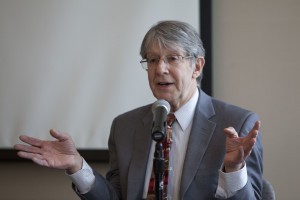
The experts agree: people still love to talk about themselves
By Lily Strelich
Chasing a compelling story, giving whistleblowers a voice or recruiting a spy—no matter what your goals are in an interview, you may face challenges getting sources to open up to you. Three professionals whose success relies on doing just that shared their unique experiences with DCSWA’s 2016 Professional Development Day attendees.
Tom Devine is a legal director at the Government Accountability Project, which helps government whistleblowers “commit the truth and get away with it,” as he put it. He emphasized the importance of being clear about what you can and can’t do to help or protect your source. A trusting relationship is essential, and getting there may mean sharing some of your own background or why the story is important to you. Enfranchise your interviewee, brainstorm with them, and follow up, Devine advised—checking in can help sustain a trusting relationship, which may be helpful for future stories.
FBI Special Agent Robin Dreeke also underscored the importance of building trust. He headed the FBI’s behavioral analysis program and honed his interview techniques recruiting enemy spies to be double agents. It may sound like something that should take action-movie bravado, but he stressed that “in order to be effective at this, you need massive amounts of humility.” Dreeke’s goal is to understand and validate the concerns of his interview subjects. He finds that people love to talk about themselves—and they respond positively if you engage, seek their opinions and help them feel heard.
For a look at how these techniques look in the kinds of interviews science writers are probably more familiar with, Caitlin Dickerson discussed methods she has honed as an investigative reporter at NPR. She sets up a meeting as soon as possible after contacting her source, and advises against starting off the record—since sources may never want to go back on. Save the hard questions for the end, once you’ve developed a rapport, Dickerson advised, and don’t be afraid to phrase the same question a few different ways—you may need to push your source a little to describe their subjective experience, rather than stick to rote details. Push for clarity, be present and don’t be too tight-lipped, Dickerson said: “If you’re holding back, the person you’re talking to is going to hold back too.”
Despite their diverse backgrounds, the panelists had some shared insights. They make sure to avoid overpromising what they can do to protect sources, and they strive to be honest about the stakes. They listen critically and carefully, and repeat a subject’s thoughts back to them to be sure they’ve gotten it right, and to make the subject feel heard. Finally, they are flexible and ready to follow the story—as Dickerson advised, “never say ‘last question.’” You never know what else you’ll uncover.
See all Professional Development Day 2016 session highlights
Curt Guyette plenary

How the confluence of citizen activism, science and journalism led to uncovering Flint’s water disaster
By Austin Hong
During a plenary talk at DCSWA’s 2016 Professional Development Day, Curt Guyette pulled back the curtain on the Flint water crisis, exposing the extent to which the city, state and even federal governments failed to ensure clean water for the Michigan community. However, Guyette also told an even larger story – one about the breakdown of democracy.
As an investigative reporter for the American Civil Liberties Union (ACLU) of Michigan, Guyette’s civil rights focus highlighted the essential element of the crisis. Flint was more than just a failure of government process, he said – it was a systematic suppression of a community’s basic rights.
Guyette began the session with a short video he had produced with the ACLU of Michigan during the summer of 2015, titled “HARD TO SWALLOW: Toxic Water Under a Toxic System in Flint.” The video revealed how Michigan state law allows the state to take decision-making power from its residents and hand it to an appointed “Emergency Manager.” To save money, the manager appointed for Flint changed the municipal water source from Detroit’s system to water from the heavily polluted Flint River, to the widespread dismay of Flint residents. As Guyette put it, “You bring in these supposed experts and they don’t have to cave into any political pressure.”
Of course, fighting the decisions of the emergency manager required more than just asking nicely. Action required information, and Guyette was willing to go to great lengths to get it. “All we wanted to do was find out the truth about the water in Flint,” said Guyette. In this pursuit, Guyette was meticulous, gathering anecdotal evidence from citizens, hiring scientists to test samples of the water from Flint, and even examining the lead testing methodology used by the state. Guyette emphasized the objectivity with which he and his collaborators approached the issue. “If we went into this, and found that the state was telling the truth about the water, then great. We would hold a press conference and confirm what the state has said and not to worry.”
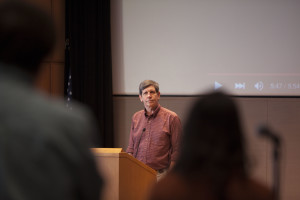 As we now know, the state testing was wrong, and lead was leaching into the water supply. The people of Flint were being poisoned, and worse, it seems that some government agencies knew what was happening and still did nothing. Guyette recalled an email from the EPA’s Region 5 water division branch chief that included the line, “I’m not so sure Flint is the community we want to go out on a limb for.”
As we now know, the state testing was wrong, and lead was leaching into the water supply. The people of Flint were being poisoned, and worse, it seems that some government agencies knew what was happening and still did nothing. Guyette recalled an email from the EPA’s Region 5 water division branch chief that included the line, “I’m not so sure Flint is the community we want to go out on a limb for.”
Thankfully, Guyette’s work paid off. The evidence he gathered, in conjunction with the citizen activists and scientists, was too damning to ignore, and major national publications took up the story. Flint has returned to sourcing water treated in Detroit (though they are now paying to rent the pipe that they had previously owned), and many of the guilty parties are either out of a job or under investigation at the federal and state levels. “There are probably about five or six people who have resigned, or gotten fired,” Guyette said. “Now the U.S. Department of Justice is investigating, the FBI is investigating, the Michigan attorney general’s office is investigating. These are all criminal investigations.”
Though no investigation can ever reverse what has happened, the people of Flint can rest assured that their voices were heard, and that the stifling of the democratic process did not go unpunished. Curt Guyette’s careful investigation brought the voices of a city to the audience of a nation, demonstrating that persistent journalism informed by science really does make a difference.
See all Professional Development Day 2016 session highlights
Tweet This, Instagram That
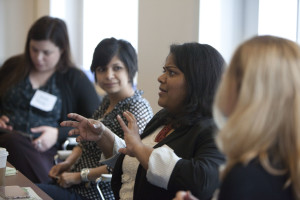
Tweet This, Instagram That
By Bree Yanagisawa
Self-promotion is a necessary but sometimes painful enterprise. And for many, figuring out how to best use the seemingly limitless supply of social media applications available can be daunting. Luckily, three industry experts were on hand at the DCSWA’s 2016 Professional Development day in Washington, D.C. to help novice and experienced science writers alike learn how to navigate the opportunity-rich but occasionally treacherous social media ocean.
Sarah Zielinski, author of the Science News blog Wild Things, represented the freelance side of the industry. Zielinski advised attendees to get the most bang for their social media buck. For her, that has meant using the two most prominent social media sites – Twitter and Facebook – to garner a following and brand herself as a science writer. Both applications can be used to do a variety of useful things for science writers, including connecting with potential sources, editors, readers and scientists. Though she said it’s important to keep up a regular social media schedule, Zielinski also noted that doesn’t hold true all the time. For instance, when a major discovery is dominating the social media scene, trying to gain attention for something else can be pointless. “There’s no point talking about koalas when everyone’s talking about gravity waves,” Zielinski advised.
Shefali Kulkarni, the audience engagement producer at BBC News, helps reporters take their stories to the next level of audience engagement. Another big proponent of Twitter, Kulkarni suggested useful tips to engage audiences, including a practice called “threading tweets,” which allows users to tie their tweets together and direct their audience’s attention better than a single stand-alone tweet can. For those overwhelmed by the thought of using social media to make connections, Kulkarni suggested thinking of the interactions instead as new ways for creating conversations. Social media is the “follow-through” to the metaphorical tennis swing that is science writing, she said; the people you engage with through social media applications can help you understand what you missed in your story.
The final panelist was Aries Keck, the social media team lead at NASA Goddard. Keck uses nearly the entire gamut of social media sources to inform and engage the public about news from NASA. She discussed how “social media can inform traditional media,” citing one example in which a series of shared social media photos of NASA scientists snowed in at work led to an article in The Atlantic. Keck also stressed that posts should be engaging, which she and her team accomplish by using visual-heavy content.
See all Professional Development Day 2016 session highlights
Giving voice to the voiceless in science writing

Amplifying the voices that need it most
By Camille von Kaenel
Reaching out to a scientist can be as easy as googling them and clicking on an email link. Finding and talking to an indigenous leader or disadvantaged community member affected by scientific research or science-related issues takes time, logistics and persistence—resources often in short supply when you’re on deadline.
But a group of reporters and advocates argued that the extra step is worth it – and offered some tips on how to bring more voices into science writing.
The ongoing water crisis in Flint, Michigan, which has also directed attention to other communities affected by pollution, made the discussion at the D.C. Science Writer’s Association 2016 Professional Development Day, titled “Giving Voice to the Voiceless”, particularly topical. Curt Guyette, the investigative reporter for the ACLU of Michigan who broke the Flint story, said he worked in unison with the city’s residents, who had been raising concerns about contaminated water long before the media started paying attention.
“They’re not voiceless,” Guyette said. “It’s just whether people are listening or not, or whether people are willing to amplify them.”
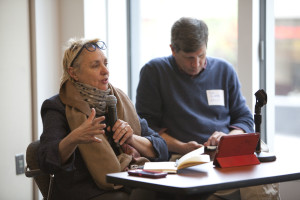
Coimbra Sirica, the vice president for global health and science at the public relations firm Burness Communications, acknowledged that it can be hard to reach the indigenous people, whose stories her firm tries to promote. To connect with indigenous people for interviews, she recommended catching them on the sidelines of major conferences that bring them to the U.S., or linking to them through researchers in the field.
Recognizing concerns reporters may come across as advocates if they promote the stories of indigenous people, Sirica told the audience that science writers have an advantage, in that they have a reputation for authority and objectivity. “You understand the evidence that supports what indigenous people are trying to tell the world,” she said.
It is not hard to find places where science intersects with inequality, panelists said. Reporters should look for places with similar hazard profiles to Flint and start talking to the residents, said Sacoby Wilson, an assistant professor of public health at the University of Maryland, College Park. Community-based groups or environmental justice research centers, or networks like the EPA’s National Environmental Justice Advisory Council, can help reporters get in touch with people on the ground, who can be as knowledgeable as scientists about the pollution affecting their communities, he said.
“Community members can be potential experts,” Wilson said. “Their data is their lived experience.”
But, he added, science writers play a critical role in turning data into stories. “Without stories, the data means nothing.”
Marissa Evans, a state health policy reporter at CQ Roll Call, reminded the audience that it matters who they choose to quote or which federal agencies they choose to profile.
“Who we deem as experts are the people who are readers will deem as experts,” she said. “And if it is always older white men, that’s a problem.”
See all Professional Development Day 2016 session highlights
How to do great investigative journalism
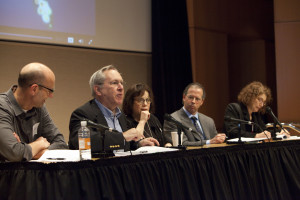
Breakout session: How to do great investigative journalism
By Janice Cessna
Four experienced investigators shared tips of the trade with a packed room at DCSWA’s 2016 Professional Development Day. Washington Post and PBS Frontline reporter David Hoffman kicked off the panel by recounting his partnership with PBS Frontline producer Rick Young on a trio of investigative reports. During each investigation, the connections the duo made with key characters gave the story life – a point reiterated by each panelist in the session.
In MIT Knight Science Journalism Program director Deborah Blum’s experience, the best investigative stories come from characters who often possess the best tips, and finding them is like a dartboard. Start by querying people on the periphery—those willing to talk even if they don’t necessarily possess the most compelling details, Blum advised. Then work their connections, then their connections’ connections, zooming in closer and closer to the central character(s) who occupy the “bull’s eye.”
During one investigation in which Blum used this process, she eventually received top-secret documents from a bull’s eye source that gave life to her story. Whether she obtains information through a source or via publicly accessible mechanisms such as a Freedom of Information Act (FOIA) request, Blum reviews the information for discrepancies and patterns. “What’s the pattern I’m seeing that no one else is?” she asks herself.
The panelists also listed top investigative resources, beginning with FOIA. Panel moderator and American University scholar-in-residence Louise Lief suggested that because the FOIA process can be lengthy and tricky, those new to the process should initially file an experimental inquiry to familiarize themselves. Blum reminded everyone to be prepared for long delays, as agencies do not respond in a timely manner, especially if they intend to impede your story. “They know you’re on a deadline and they can run your clock out,” she said.
However, there are also government groups that work symbiotically with journalists to publicize issues. Investigator Doug Pasternak explained that the U.S. House of Representatives Oversight Committee on Science, Space and Technology frequently provides journalists report and information access and receives their assistance with research and interviewing sources. Pasternak also recommended cultivating relationships within the Government Accountability Office, as its staff typically has advance access to reports prior to public release, and often uses this period to clue in journalists.
The panelists collectively provided additional pointers. Leaks from organizations with issues or skeletons often come from the bitter, disillusioned staff employed within them. Relationships with watchdog and advocacy groups often yield tips. Sometimes it can take time for sources to open up, so cultivate and maintain relationships over the long term. And sometimes honesty opens up unlikely avenues to a story. “Just keep knocking on the door,” said Young. “Be straightforward about what the story is about and what you want to tell.”
The long-term nature of developing relationships and finding sources is reflected in the overall lengthy process of substantive investigative journalism. Thus, many journalists may find it’s possible to work on such stories only if they are maintained on the workload periphery, and nurtured periodically as things evolve, versus working exclusively on them for an extended period.
And all the investigation in the world won’t get the public’s attention unless it’s packaged into a powerful story that brings the issue to a personal level so that viewers, or readers, can relate, Hoffman reminded the audience. At its best, he said, investigative journalism is a combination of sleuthing, science and narrative. “I firmly believe part of our job is as a storyteller,” Hoffman said.
All panelists agreed that the human element is essential. As Young put it: “You need to find characters— those people who can dramatize what’s going on.”
Additional Suggested Resources
- Muckrock: offers FOIA resources, including tracking inquiries and adding your FOIA document results to their collection
- Knight Science Journalism Program at MIT: Through the Resources tab, provides journalism tools and tips, including links to approximately 30 science databases
- EPA Toxics Release Inventory (TRI): Database of reports filed by chemical companies, searchable by state
- Investigative Reporters & Editors: Resource Center with reporting tip sheets, templates for filing FOIA requests, resource bookstore and more
- Government agencies: Some publicly post documents directly on their websites
- Finding funds for international reporting: Session summary from DCSWA’s 2015 Professional Development Day, including links to potential funding sources, some of which are specifically geared toward investigative subjects
Home
The D.C. Science Writers Association is a group of journalists, writers, public information officers (PIOs), and audio and video producers who cover breaking research, science and technology. Our events bring together science writers for socializing, networking, science-based tours and events, and professional development workshops. The D.C. Science Writers Association is dedicated to providing a safe and welcoming experience for everyone, regardless of gender, gender identity and expression, sexual orientation, disability, physical appearance, body size, race, age, national origin, or religion. DCSWA does not tolerate harassment of members in any form.

